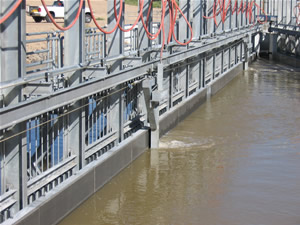Fish screen

A fish screen is a structure built to prevent fish from entering hydroelectric dams, aqueducts, diversion rivers, or other man-made structures. These screens are meant to supply water free of debris to power plants and other facilities without harming aquatic life. Although these screens are built with the goal of preventing fish from being harmed if they enter dams or aqueducts, the collision of fish with the screen can sometimes hurt the fish.[2]
Fish screens can be round, square, or rectangular in shape. However, they must not include any sort of sharp protrustion that could injure fish that collide with the screen. Generally, fish screens are made of some material that allows water to flow through the screen while blocking fish and debris from flowing through. They can be made of perforated metal, netting, or fence-wire. Metals that can be used to make fish screens include brass, bronze, aluminum, galvanized or stainless steel, and plastics.[2] Whichever material is used, the screen must be resistant to corrosion and deterioration as a result of exposure to ultraviolet light.
Installation and Maintenance
The proper installation of fish screens is vitally important in ensuring that they function properly. These screens should be located in areas that see relatively low fish traffic throughout the year. As well, these screens should be located away from structures that could attract fish that are migrating or spawning. Additionally, the screens should be located slightly above the bottom of the waterway to ensure excessive amounts of sediment or bottom-dwelling organisms are not scooped into the screen.
As well, these screens must be cleaned and maintained regularly to ensure that excessive debris does not accumulate on the screens and produce conditions that could harm fish. These screens are removed and cleaned with air or water, and can be pressure washed or scrubbed. A suction pipe can be used to easily remove debris from the screen.
References
- ↑ Wikimedia Commons. (August 24, 2015). Fish screen [Online]. Available: https://commons.wikimedia.org/wiki/File:Fish_screen-Redlands_Canal.jpg
- ↑ 2.0 2.1 Department of Fisheries and Oceans. (August 24, 2015). Freshwater Intake End-of-Pipe Fish Screen Guideline [Online]. Available: http://www.dfo-mpo.gc.ca/Library/223669.pdf

